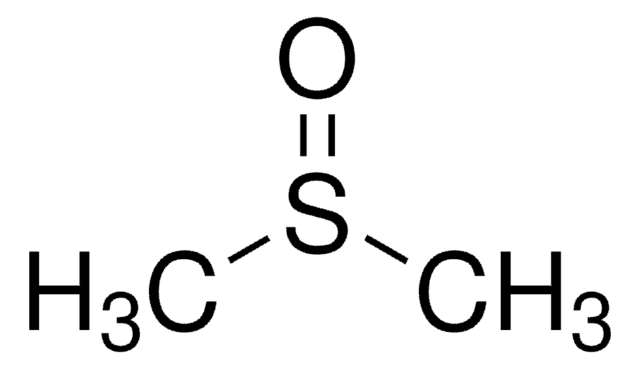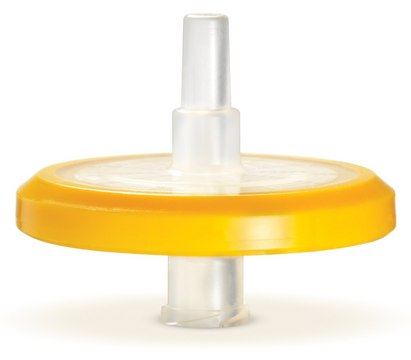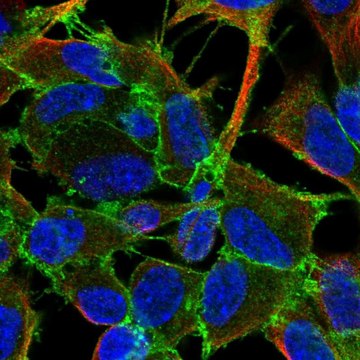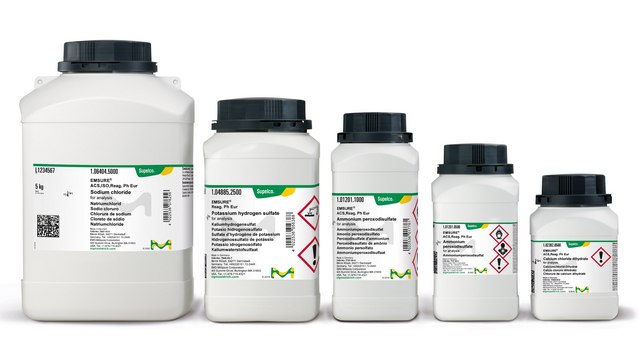All Photos(4)
Synonym(s):
Transmembrane channel-like protein 1, Beethoven protein, Deafness protein, Transmembrane cochlear-expressed protein 1
UNSPSC Code:
12352203
eCl@ss:
32160702
NACRES:
NA.41
Recommended Products
biological source
rabbit
Quality Level
antibody form
serum
antibody product type
primary antibodies
clone
polyclonal
species reactivity
mouse, monkey
packaging
antibody small pack of 25 μL
technique(s)
immunocytochemistry: suitable
immunofluorescence: suitable
western blot: suitable
isotype
IgG
NCBI accession no.
UniProt accession no.
target post-translational modification
unmodified
Gene Information
mouse ... Tmc1(13409)
Related Categories
General description
Transmembrane channel-like protein 1 (UniProt: Q8R4P5; also known as Beethoven protein, Deafness protein, Transmembrane cochlear-expressed protein 1, TMC1) is encoded by the Tmc1 (also known as Bth, dn) gene (Gene ID: 13409) in murine species. TMC1 is a multi-pass membrane protein that forms ion channel required for the normal function of cochlear hair cells. It is detected in cochlear inner and outer hair cells and in neurosensory epithelia of the vestibular end organs. Its expression is also reported in cortex, cerebellum, eye, colon, ovary, and testis. It is expressed at low levels in temporal bone from embryonic day 14 to day 1 after birth in mice and increases significantly (8 to 16 fold) at day 5, 10 and 20 and then continues to be expressed up to day 90. Two isoforms of TMC1 have been reported in mice that are produced by alternative splicing. Mutations in Tmc1 gene can cause hearing loss in humans and mice. Heterozygotes show progressive hair-cell degeneration from day 20 onwards in mice, leading to severe depletion of inner hair cells and scattered loss of outer hair cells, and progressive loss of the Preyer reflex from around day 30. Homozygotes show almost complete degeneration of inner hair cells, and little or no Preyer reflex at any age.
Specificity
This rabbit polyclonal antibody detects Transmembrane channel-like protein 1 in murine retina. It targets an epitope within 20 amino acids from the N-terminal region.
Immunogen
Epitope: cytoplasmic domain
KLH-conjugated linear peptide corresponding to 20 amino acids from the N-terminal cytoplasmic domain of murine Transmembrane channel-like protein 1.
Application
Anti-TMC1, Cat. No. ABN1649, is a highly specific rabbit polyclonal antibody that targets Transmembrane channel-like protein 1 and has been tested for use in Immunocytochemistry, Immunofluorescence, and Western Blotting.
Immunocytochemistry Analysis: A 1:100 dilution from a representative lot detected TMC1 in COS-7 cells.
Immunofluorescence Analysis: A representative lot detected TMC1 in P9 mouse outer hair cells (OHCs) (Kurima, K., et. al. (2015). Cell Rep. 12(10):1606-17).
Western Blotting Analysis: A representative lot detected TMC1 in COS-7 cells (Labay, V., et. al. (2010). Biochemistry. 49(39):8592-8).
Western Blotting Analysis: A 1:1,000 dilution from a representative lot detected TMC1 in HEK293 cells transiently transfected with Fugene and TMCx-cherry cDNAs (Courtesy of Dr. Angela Ballesteros).
Immunofluorescence Analysis: A representative lot detected TMC1 in COS-7 transfected cells expressing TMC1-GFP (Courtesy of Dr. Angela Ballesteros).
Immunofluorescence Analysis: A representative lot detected TMC1 in P9 mouse outer hair cells (OHCs) (Kurima, K., et. al. (2015). Cell Rep. 12(10):1606-17).
Western Blotting Analysis: A representative lot detected TMC1 in COS-7 cells (Labay, V., et. al. (2010). Biochemistry. 49(39):8592-8).
Western Blotting Analysis: A 1:1,000 dilution from a representative lot detected TMC1 in HEK293 cells transiently transfected with Fugene and TMCx-cherry cDNAs (Courtesy of Dr. Angela Ballesteros).
Immunofluorescence Analysis: A representative lot detected TMC1 in COS-7 transfected cells expressing TMC1-GFP (Courtesy of Dr. Angela Ballesteros).
Research Category
Neuroscience
Neuroscience
Quality
Evaluated by Western Blotting in mouse retinal tissue lysate.
Western Blotting Analysis: A 1:500 dilution of this antibody detected TMC1 in 10 µg of mouse retinal tissue lysate.
Western Blotting Analysis: A 1:500 dilution of this antibody detected TMC1 in 10 µg of mouse retinal tissue lysate.
Target description
~90 kDa observed; 87.26 kDa calculated. Uncharacterized bands may be observed in some lysate(s).
Physical form
Rabbit polyclonal antiserum with 0.05% sodium azide.
Unpurified
Storage and Stability
Stable for 1 year at -20°C from date of receipt. Handling Recommendations: Upon receipt and prior to removing the cap, centrifuge the vial and gently mix the solution. Aliquot into microcentrifuge tubes and store at -20°C. Avoid repeated freeze/thaw cycles, which may damage IgG and affect product performance.
Other Notes
Concentration: Please refer to lot specific datasheet.
Disclaimer
Unless otherwise stated in our catalog or other company documentation accompanying the product(s), our products are intended for research use only and are not to be used for any other purpose, which includes but is not limited to, unauthorized commercial uses, in vitro diagnostic uses, ex vivo or in vivo therapeutic uses or any type of consumption or application to humans or animals.
WGK
WGK 1
Certificates of Analysis (COA)
Search for Certificates of Analysis (COA) by entering the products Lot/Batch Number. Lot and Batch Numbers can be found on a product’s label following the words ‘Lot’ or ‘Batch’.
Already Own This Product?
Find documentation for the products that you have recently purchased in the Document Library.
Our team of scientists has experience in all areas of research including Life Science, Material Science, Chemical Synthesis, Chromatography, Analytical and many others.
Contact Technical Service







